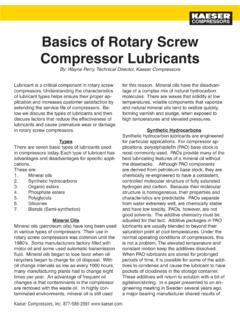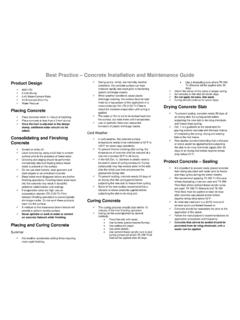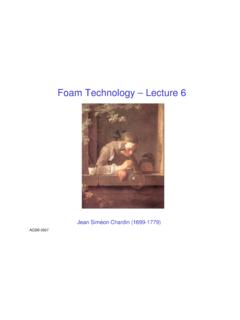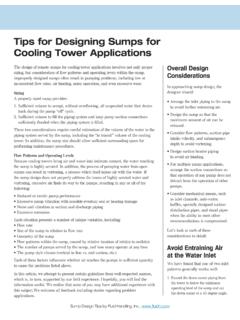Transcription of A Study of Compressor Oils - Synlubes Inc.
1 A Study of Compressor oils white paper 7-1. G-1592. AMSOIL Industrial Division November 2005. Published 2006, AMSOIL INC. Table of Contents Desired Performance Characteristics and Oxidation Rotating Pressure Vessel Oxidation Test (RPVOT) ASTM Correlation to Field Water ..6. Hydrolytic Stability ASTM Acidity of Water The Appearance of the Copper Weight Change of Copper Percent Change in Water Demulsibility ASTM Correlation to Field Internal Component Rust Prevention in Synthetic Sea Water ASTM Correlation to Field Foam Stability ASTM Correlation to Field Wear Wear Preventative Characteristics of Lubricating Fluid ASTM D-4172 (4-Ball Method)..11. Correlation to Field Copper Corrosion ASTM Entrained Air Release ASTM Correlation to Field Physical Viscosity Index ASTM Correlation to Field Viscosity at 40 C ASTM Correlation to Field Pour Point ASTM Correlation to Field Test Results Affidavit of Affidavit of Test 2.
2 Overview Compressed air is a critical part of many manufacturing facilities; without it, production would cease. Reliable air compres- sor operation is essential to manufacturing production. Lubrication is key to keeping air compressors running and is some- times called the Compressor 's life-blood. Compressor lubricants are produced by many lubricant manufacturers, ranging in quality from poor to excellent. Poor air Compressor oil could cause the Compressor to have a very short life, but excellent quality air Compressor oil reduces maintenance and can extend Compressor life. Some end users find comfort in using the manufacturer recommended oil because of perceived quality. The American Petroleum Institute (API) governs the minimum quality standards for engine oils .
3 Air Compressor oils are not governed by any organization, so no official performance standards exist. This leaves the responsibility for producing a sat- isfactory product to the individual lubricant manufacturers. Air Compressor original equipment manufacturers (OEM) help eliminate some confusion by publishing minimum oil speci- fications required for their individual air compressors. These minimum oil specifications insure minimum lubricant perform- ance. Any oil that meets or exceeds the minimum specifications can be used without voiding the standard or regular com- pressor warranty (usually one or two years). While OEMs do not manufacture their own Compressor oil, they frequently mar- ket their own brand of Compressor oil and have often been able to tie separately purchased extended warranty requirements to the use of their own branded oil.
4 Air Compressor companies must contract with a lubricant company to manufacture oil for them. When the air Compressor manufacturers purchase oil from a lubricant manufacturer they become the middlemen and the cost is increased to the con- sumer. OEM branded Compressor oils provide the allure of quality, but in many cases the price of these oils is unneces- sarily inflated and is frequently exorbitant. In addition, these oils often do not have the best performance characteristics that are available on the market. Purpose The purpose of this paper is to inform consumers about the performance and cost differences between Compressor oils , including OEM branded and popular aftermarket products. These evaluations will provide consumers the confidence in which to purchase high-quality Compressor oil at the lowest possible price.
5 Method The testing by which these oils are evaluated is done in accordance with American Society for Testing and Materials (ASTM) procedures. The results of these tests can be duplicated and verified by laboratories that conduct these ASTM. tests. A notarized affidavit certifying the results are correct is included in the appendix. Compressor oil pricing was deter- mined by contacting the manufacturer or the distributor and requesting a quote on a five-gallon pail and a fifty-five gallon drum of their lubricant. Price quotes obtained are listed in the pricing section. Scope This paper is focused on rotary screw type Compressor oils . Rotary screw compressors are widely used in all types of indus- tries, and synthetic Compressor oils are recognized as superior to mineral-based Compressor oils by Compressor manu- facturers as well as most oil companies and consumers.
6 ASTM tests conducted were chosen respective of rotary screw Compressor environments. While there are many tests by which oils could be measured, the information provided by the tests and included in this paper gives a well-rounded view of the Compressor oil's performance. 3. Desired Performance Characteristics and Results oils used in rotary screw compressors operate in severe environments. In order to list the desired performance character- istics of Compressor oils , it is important to first understand the environment the oil must withstand inside the screw com- pressor (see diagram I). Air enters the Compressor through an air intake filter. The air Compressor oil is injected into the Compressor and is compressed with the air. During the air compression process heat is generated and small amounts of moisture contained in the air mix with the oil.
7 Moisture, when mixed with oil, can cause oil water emulsions, rust and foam- ing. The compressed air/oil mixture then enters the air/oil separator where the hot oil and air are separated by the oil sep- arator element. The compressed hot air then goes through a cooler, where the moisture in the air condenses and can be drained off. The air then goes to the plant to run production equipment. The hot oil goes through the oil cooler and is then injected back into the Compressor once again. This process can be continuous for up to 8,000 hours or more. Oil degrada- tion can result in acid buildup, hydrolysis and oxidation. Through the compression process the oil is expected to provide the following functions: Oxidation resistance from the heated air/oil compression Resist acid buildup due to oxidation from extended oil drain intervals, moisture and heat Exhibit good demulsibility to separate the water from the oil Prevent against internal rust formation Resist foaming Control air entrainment Reduce wear Maintain viscosity parameters Extend oil drain intervals Provide low temperature fluidity protection Diagram I.
8 4. Oxidation Resistance The high-speed rotors in rotary screw air compressors compress large volumes of air. At the same time, oil is injected into the rotors to lubricate the moving parts during compression. The hot oil and air mixture can increase the rate of lubricant degradation through oxidation. The evaluated oils were subjected to the Rotating Pressure Vessel Oxidation Test in order to simulate air Compressor oil oxidation while in service. Rotating Pressure Vessel Oxidation Test (RPVOT) ASTM D-2272. The Rotating Pressure Vessel Oxidation Test is a rapid method of comparing the oxidation life of new or in-service lubri- cants. The vessel is initially charged with 50 grams of test oil and five grams of distilled water. A copper catalyst is added, and the vessel is pressurized with oxygen to 90 PSI at room temperature and submerged into a 150 C (302 F) tempera- ture bath.
9 The bath temperature causes this pressure to increase to approximately 200 PSI. The vessel is rotated and as oxygen is absorbed into the oil from oxidation, a pressure drop occurs. The failure point is taken as a 25-PSI drop from the maximum pressure attained at 150 C (302 F). The results are reported as the number of minutes until a 25-PSI loss occurs. Correlation to Field Service The Rotating Pressure Vessel Oxidation Test (RPVOT) is useful in estimating the oxidation stability of oils . The RPVOT can also be used to compare new oils to provide a correlation between the RPVOT value and an oil's useful life before oxida- tion occurs. A high RPVOT number correlates to high oxidation resistance and long oil life. A low RPVOT number correlates to low resistance to oxidation and short oil life.
10 RPVOT Oxidation Test 2250. 2000. 1750. 1500. 1250. 2025. 1830. 1000. 750. 1356. 1302. 1300. 1200. 1075. 1000. 500. 550. 405. 250 395. 00. us of co SP r 25. 6. 0. 6. 46 le I. 0 ve nt nd 0. PC. -4. 46. 04. us ilm rp Pl 80. id ot op 10. 90 en la a SH. lu S- l3. nf Pu Pl oo l R. IL. II/. -R C. yn N D. C. ro SO. er H las it ns F. C ol SH. Sy al O er m de SR. es a rs oy ui AM. AE dn At m An ltr e us Ka Q. R. D. Su U Ing ir ar ar lla y G. nc R. Su ui il ob Q. M. 5. Water Resistance When air or process gases are compressed, moisture from humidity condenses and collects in the oil, creating the need for the oil to have good hydrolytic stability. Good hydrolytic stability is important as this helps prevent oil degradation from hydrolysis, which forms acids and contributes to foaming.






